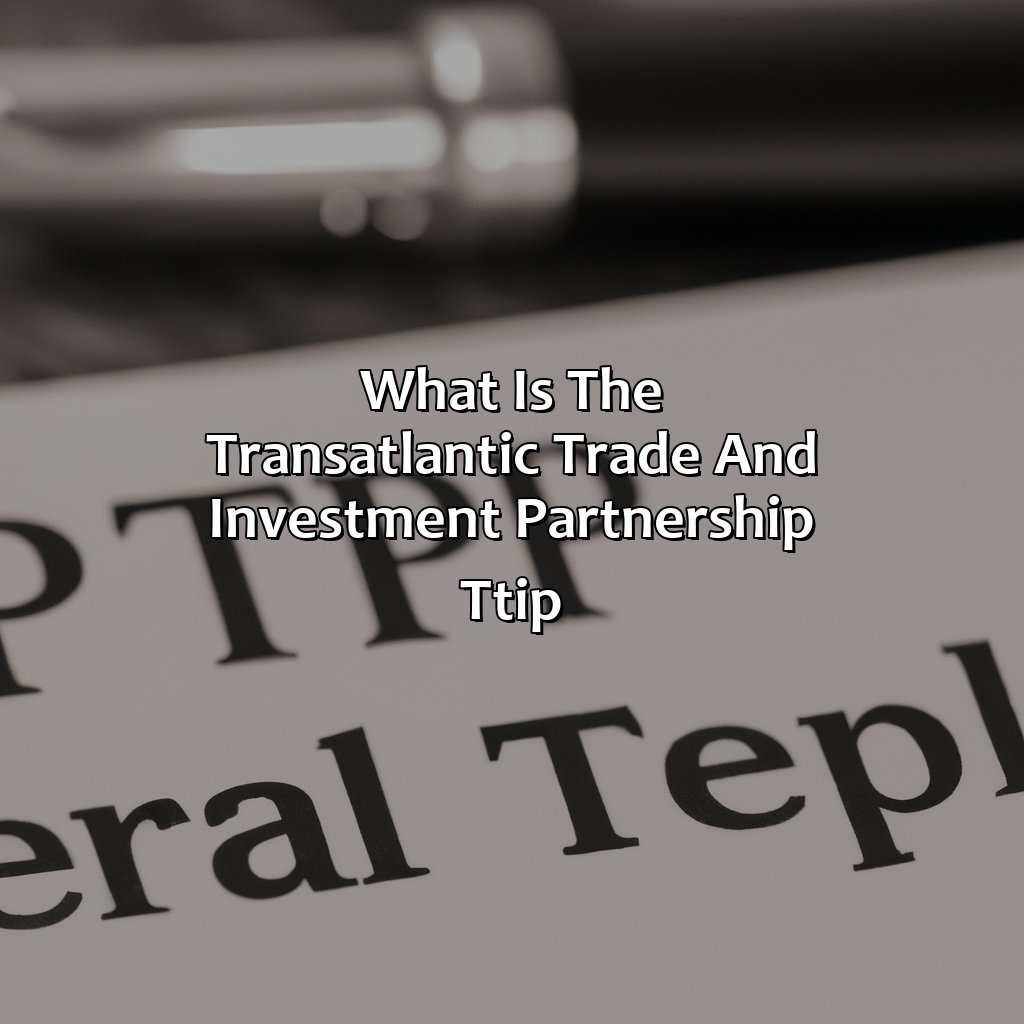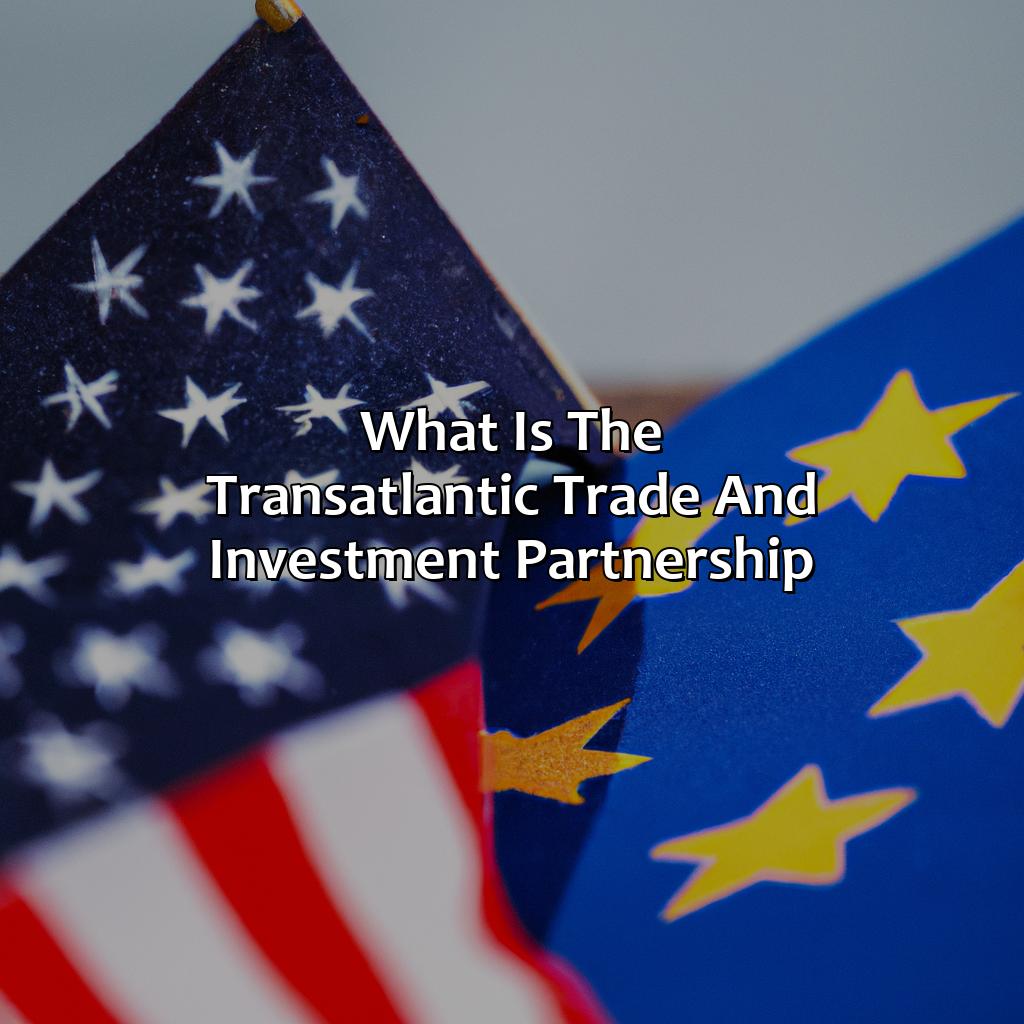What Is The Transatlantic Trade And Investment Partnership?
Key Takeaway:
- The Transatlantic Trade and Investment Partnership (TTIP) is a proposed trade agreement between the European Union (EU) and the United States, aimed at reducing trade barriers and increasing market access on both sides of the Atlantic.
- The TTIP has the potential to bring significant economic benefits to both economies, such as increased investment, job creation, and economic growth. However, critics argue that the agreement could lower environmental and labor standards and harm small businesses and consumers.
- The negotiating parties involved in the TTIP include the EU and the U.S., as well as various interest groups and stakeholders. Despite several rounds of negotiations, the agreement has yet to be finalized and faces uncertain prospects in the future.
1. The Transatlantic Trade and Investment Partnership (TTIP) is a proposed trade agreement between the European Union (EU) and the United States, aimed at reducing trade barriers and increasing market access on both sides of the Atlantic.
2. The TTIP has the potential to bring significant economic benefits to both economies, such as increased investment, job creation, and economic growth. However, critics argue that the agreement could lower environmental and labor standards and harm small businesses and consumers.
3. The negotiating parties involved in the TTIP include the EU and the U.S., as well as various interest groups and stakeholders. Despite several rounds of negotiations, the agreement has yet to be finalized and faces uncertain prospects in the future.
Are you trying to understand the intricate details of the Transatlantic Trade and Investment Partnership (TTIP)? Let us empower you with knowledge on this critical trade agreement and its potential benefits for you.
What is the Transatlantic Trade and Investment Partnership (TTIP)?
Transatlantic Trade and Investment Partnership (TTIP) is a trade agreement between the European Union and the United States, aimed at reducing barriers to trade and investment. This agreement was developed to increase economic growth, create jobs and promote trade on both sides of the Atlantic. It aims to make it easier for companies to do business, by reducing costs and regulatory barriers. The TTIP negotiations cover various sectors, including agriculture, automotive, chemicals, and services, among others.
The TTIP has been controversial as it has been criticized for lack of transparency and potential negative impact on environmental, social and democratic standards. Some critics also argue that it could lead to a race to the bottom in terms of regulation and standards. Proponents argue that it could provide significant benefits, including increased economic growth and job creation.
It is important to note that negotiations for the TTIP have been suspended since 2016, and it is unclear if they will continue in the future. However, the underlying issues around trade and investment between the EU and the US continue to be relevant, and discussions are ongoing.
In a similar vein, the Comprehensive and Progressive Agreement for Trans-Pacific Partnership (CPTPP) was signed in 2018, covering economies in Asia, America and Australia. It aims to achieve similar goals as the TTIP, in terms of reducing trade barriers and increasing economic integration.

Image credits: retiregenz.com by David Woodhock
Purpose and Significance of the TTIP
To grasp the TTIP’s intent and importance, you must comprehend the advantages and criticisms that come with it. Examining the rewards it brings to economies and businesses, as well as the doubts and worries, is essential to appraise the possible effect of this global trade pact.

Image credits: retiregenz.com by James Washington
Benefits of the TTIP for economies and businesses
The implementation of the Transatlantic Trade and Investment Partnership will bring about ample benefits for both economies and businesses. Enhanced trade agreements, improved access to markets, and reduced regulatory barriers will improve the mobility of goods and services between the United States and Europe. This is expected to lead to increased economic growth by creating new investment opportunities, promoting innovation, and reducing costs.
TTIP offers an opportunity for small businesses to expand their operations by enabling simplified regulations with less bureaucratic procedures. Essentially, TTIP will provide a level playing field for both large and small enterprises in the competitive global market. Businesses that choose TTIP will also benefit from reduced tariffs on exports, increased opportunities for growth as well as overall efficiency.
TTIP provides not only substantial business benefits but also ensures a strong collaboration between countries considering environmental protections as one of the top priorities. This agreement encourages precision conservation allowing governments in both regions to ensure that economic development practices positively impact conservation efforts. With numerous advantages like these impossible to ignore or pass up on, it becomes crucial for businesses to consider embracing this new transatlantic trade initiative.
The proposal of the TTIP is yet another great opportunity knocking at our doors. Failing to seize upon this chance could end up being a significant setback for participating economies ultimately resulting in compromising international competitiveness and loss of significant value perception among investors. Therefore, leaders around the world need to take action now so that they do not fall behind while others move ahead.
Why settle for a mere trade deal when you can have a controversial one with potential global consequences?
Criticisms and concerns surrounding the TTIP
The Transatlantic Trade and Investment Partnership (TTIP) has been heavily criticized, with concerns ranging from lowered labour standards and environmental protection to increased corporate power. Opponents argue that the agreement favours large corporations at the expense of small businesses and ordinary citizens. Moreover, critics express concern over private tribunals that could undermine democracy by allowing corporations to sue governments for lost profits. Others worry that TTIP will lead to rising healthcare costs and erode food safety regulations.
Unique details include concerns about intellectual property rights and fears about the potential impact on European cultural industries. The agreement may also negatively affect developing countries by increasing protection for Western markets while leaving these countries excluded.
To address these criticisms, some suggest stricter regulatory standards and policies to protect workers’ rights and the environment. Additionally, negotiators could promote greater transparency by releasing more information on the agreement’s contents and negotiations process. Ultimately, creating a fairer, more democratic trade deal is necessary to prevent the negative effects of TTIP from outweighing any potential benefits.
Negotiations for the TTIP are like a never-ending game of poker, where the stakes are higher than a skyscraper and the players can’t seem to agree on anything except free drinks.
Negotiations, Content, and Status of the TTIP
Want to know the scoop on the Transatlantic Trade and Investment Partnership (TTIP)? Get your feet wet by diving into the details. Uncover who’s involved and their positions on the TTIP. Plus, find out how the U.S. quitting the negotiations might affect the agreement.

Image credits: retiregenz.com by Harry Arnold
Key negotiating parties and their stances on the agreement
The involved parties and their stances on the Transatlantic Trade and Investment Partnership (TTIP) are vital information to understand this agreement. Here’s a breakdown of where each country stands:
| Country | Stance |
|---|---|
| United States | Pro-TTIP |
| European Union | Pro-TTIP |
| Germany | Both pro and anti-TTIP |
| France | Anti-TTIP |
| United Kingdom | Pro-TTIP (prior to Brexit) |
| Canada | Pro-TTIP |
It’s worth highlighting that Germany is in a unique position where some politicians/supporters are for it, while others are against it.
Notably, according to the Pew Research Center, only 53% of Americans were in favor of the agreement in 2016. There goes the chance of getting a good deal on American cheese and cowboy hats.
The potential impact of the U.S. withdrawal from the TTIP negotiations on the partnership
The departure of the United States from negotiations of the Transatlantic Trade and Investment Partnership (TTIP) has great consequences that can lead to a significant impact on the partnership. The withdrawal limits possible market opportunities for European businesses, reducing their competitiveness in global markets. It also raises concerns about potential trade conflicts and equality among trading partners.
In addition, the termination of the TTIP diminishes America’s role as a key player in international economic affairs, creating uncertainty in global markets and negative implications for American businesses and investors.
Pro Tip: The future direction of transatlantic trade relations will require open communication channels between both parties to sustain a healthy trade environment without succumbing to protectionism.
Five Facts About the Transatlantic Trade and Investment Partnership:
- ✅ The Transatlantic Trade and Investment Partnership (TTIP) is a proposed trade agreement between the European Union and the United States. (Source: European Commission)
- ✅ The aim of the TTIP is to remove trade barriers and promote economic growth and job creation. (Source: USTR)
- ✅ The negotiations for the TTIP began in 2013 and were officially put on hold in 2016. (Source: BBC News)
- ✅ Supporters of the TTIP argue that it would boost economic growth and strengthen the transatlantic alliance. (Source: FT)
- ✅ Critics of the TTIP are concerned about its potential impact on labor rights, food safety, and the environment. (Source: Friends of the Earth Europe)
FAQs about What Is The Transatlantic Trade And Investment Partnership?
What is the Transatlantic Trade and Investment Partnership?
The Transatlantic Trade and Investment Partnership (TTIP) is a proposed free trade agreement between the European Union (EU) and the United States (US) that aims to remove trade barriers and increase economic growth and investment.
What are the main objectives of TTIP?
The main objectives of TTIP are to: 1) reduce barriers to trade and investment, 2) improve access to each other’s markets, 3) create new investment opportunities, and 4) promote the development of global trade rules.
What are some of the issues related to TTIP?
There are several issues related to TTIP, including concerns about transparency, potential harm to environmental and health standards, and the impact on small businesses and local economies. There are also disagreements about intellectual property, geographical indications, and the investor-state dispute settlement mechanism.
Who is involved in the negotiation of TTIP?
The negotiation of TTIP involves representatives from the European Union (EU) and the United States (US), including trade negotiators, government officials, and industry stakeholders. The negotiations are conducted by the Office of the United States Trade Representative and the European Commission.
Has TTIP been implemented?
No, TTIP has not been implemented. The negotiations for TTIP began in 2013 but were put on hold in 2016 due to concerns about transparency and public resistance to the agreement. It is uncertain whether negotiations will resume in the future.
What is the current status of TTIP?
The negotiations for TTIP were put on hold in 2016 and have not resumed. The current status of TTIP is uncertain, and it is unclear whether negotiations will resume in the future.


